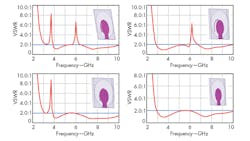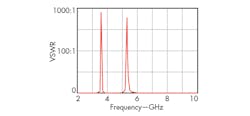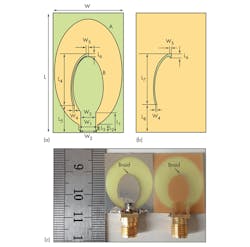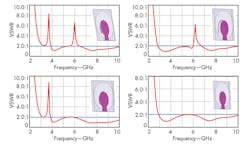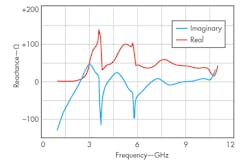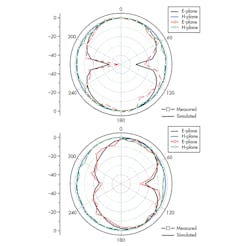UWB Antenna Adds Dual-Band Notches
This file type includes high resolution graphics and schematics when applicable.
The number of applications utilizing ultrawideband (UWB) electronic systems has increased, but these applications all rely upon effective antenna designs. For practical use, UWB antennas should also coexist with narrowband applications within the UWB frequency range, and this can be done via the inclusion of band notches within the antenna’s UWB frequency coverage range.
Fortunately, an equivalent circuit has been developed for an UWB antenna with a pair of frequency notches to minimize interference from narrowband applications. The equivalent circuit was used to produce a printed-ellipse-slot (PES) UWB antenna with a frequency range of 3.0 to 10.8 GHz, in addition to band-notched functions at 3.30 to 3.89 GHz and 5.6 to 6.1 GHz.
These band-notched functions can be realized by adding two “braids” to the antenna design—braids which are equivalent to two series inductance-capacitive (LC) resonances in the antenna circuitry. The notched bands can be used to cover working bandwidths of 5.725 to 5.850 GHz for wireless local area networks (WLANs) and 3.30 to 3.70 GHz for WiMAX, minimizing interference from those applications for UWB systems.
UWB systems are gaining attention for their capabilities to support high transmission rates at low power levels and small-sized circuits.1,2 Because of existing applications operating within the UWB frequency range, such as WLAN and WiMAX systems, the interference from these more narrowband applications must be resolved before UWB circuits can be used. One possible solution is the addition of a bandstop filter to the UWB system, although the filter adds complexity. A more practical approach is the use of an antenna with band-notched functions.
Various methods can be employed to realize band-notched functions in an antenna with UWB coverage. These include adding parasitic elements,3-5 using matching units,6 working with a slot antenna,7-11 and using a fractal antenna.12 Methods for achieving band-notched functions in an antenna are based on adding a parallel or series LC resonator to the antenna.
For a slot antenna with band-notched functions, the slot in the radiating unit serves as a parallel or series LC resonator.13 Adjusting the spectral position of the band notch involves changing the size of the slot. Also, the A band-notched antenna function can also be realized by means of split-ring resonators, although this requires a typically artificial electromagnetic (EM) structure.
As a practical solution, a wideband planar monopole antenna was developed with two braids to achieve the two band notches. The approach yields effective results without adding undue complexity to the antenna. To reinforce the validity of the approach, simulation results based on the High Frequency Structure Simulator (HFSS) electromagnetic (EM) simulation software from Keysight Technologies (formerly Agilent Technologies) will be presented along with experimental results.
The basic principle of a dual-band notched antenna is somewhat equivalent to adding two bandstop filters to an antenna. In the process of designing such an antenna, the bandstop filters can be alternated by using special structures, much like the braids described in this report. The braids within the antenna play a role much like filters to reject two target frequency bands.
The antenna operates in a transmission-line-like mode. The UWB antenna and feeder are equivalent to a 50-Ω load in the equivalent circuit, with two simple series LC branches added to the circuit (Fig. 1). Using the Advanced Design System (ADS) simulation software from Keysight to obtain simulation data (Fig. 2) for use as a reference, the results shows that two obvious band-notched functions are realized at 3.6 and 5.7 GHz, when L1 = 28 nH, C1 = 0.292 pF, L2 = 3.567 nH, and C2 = 0.586 pF.
The simulation results confirmed that adding two series LC resonances to the antenna circuit is a feasible way to obtain the dual-band-notched characteristics. The LC resonances can be realized by means of special structures, but a number of steps should be taken beforehand. First, to confirm whether a special structure will provide the desired resonance, the input impedance of the proposed antenna should be well known. According to resonance theory, the imaginary part of the input impedance should have two downward trends at the notch frequency points.
Second, the notch frequency spectral responses should be somewhat adjustable, which requires that the structures used for the resonances should be isolated and adjustable independently. Finally, any added structures should not impact the directional and/or impedance-matching characteristics of the original UWB antenna design.
Based on this analysis, an UWB antenna with standard band-notched functions at 3.3 to 3.89 GHz and 5.6 to 6.1 GHz was developed (Fig. 3). It was fabricated on high-frequency substrate material with dielectric constant of 4.5, loss tangent of 0.0035, and thickness (h) of 1 mm. The antenna features an elliptically shaped radiating patch.
This file type includes high resolution graphics and schematics when applicable.
Additional Improvement
This file type includes high resolution graphics and schematics when applicable.
To further improve the antenna impedance, a rectangular slot measuring L2 × 3 × W1 was etched from the antenna’s coplanar-waveguide (CPW) ground plane. The axis of the ellipse A is 11.7 mm, with an axial ratio of 0.747. The axis of ellipse B is 6.5 mm, with an axial ratio of 0.6. The two braids are obtained by using a larger ellipse with axis of 7.5 mm and axial ratio of 0.6 inserted by a smaller ellipse with axis of 7.1 mm and axial ratio of 0.6.
The quality of the band-notched antenna’s response is mainly determined by the location of the stopbands and the frequency ranges of the notches. Theoretical analysis shows that band notch location is mainly related to the length of the braid. To better understand this, the effects of different lengths of inductors L4 and L7 and different structures with one or two braids were examined.
Figure 4 shows the antenna’s reflection coefficients when loaded with different structures. The results show that the original UWB antenna (without braids) offers good impedance response from 3.0 to 10.8 GHz, with each of the braids helping to remove interference at the band-notched frequencies.
Figure 5 shows the influence of different braid lengths on notch frequency location. The lengths of the braids are changed indirectly by adjusting the values of inductors L4 and L7. The results indicate that when L4 varied from 10.7 to 11.7 mm, the stopband at 3.6 GHz shifts to a lower frequency, and a small shift in notch center frequency at 5.7 GHz occurs; the notch frequency range also shows improvement.
Similar results occur with an increase of L7 from 10.2 to 12.2 mm. The results show that the band-notched characteristics at 5.7 GHz are mainly affected by the lower braid, with the other notch mainly affected by the upper braid. Because the structures are effective independent of each other, each of the two band-notched characteristics can be adjusted independently by modifying the parameters of each structure (see table).
Figure 6 presents surface current distributions at 3.6 and 5.7 GHz for the antenna. It shows that current is mainly distributed around the two braids at 5.7 GHz. The current vector diagram also shows that the current is in resonance between the two braids. At 3.6 GHz, the current is mainly distributed near the above braids. Analyzed intuitively, because of the current is in resonance around the braids, the additional structures can be considered as two LC resonances at notch center frequencies, limiting energy radiated outward. Further analysis will be needed to determine whether the two braids are equivalent to two LC series resonances.
Figure 7 shows the input impedance for the proposed antenna. Two sudden drop points can be seen from the imaginary part of impedance (the dashed line), corresponding to two notch-frequency-point positions. The impedance plot shows that the imaginary part of impedance is small enough at the notch center frequency. Analyzed from the theory of resonance, the two LC resonances (corresponding to the two braids) can be considered equivalent to two series LC resonances.
Figure 8 shows the E- and H-plane radiation patterns of the fabricated antenna at 3 and 7 GHz. The simulated and measured results both exhibit relatively omnidirectional radiation patterns. The radiation patterns actually resemble those of a vertical dipole antenna. They also show that the added structures have little effect on the radiation patterns of the modified antenna compared to the original antenna design.
Figure 9 shows the simulated and measured VSWR results for the proposed antenna. The simulated and measured results show good performance and consistency, with clear band-notched characteristics at 3.5 and 5.7 GHz. These results point to this antenna design, with its dual-band-notched characteristics, as a viable candidate for UWB applications where interference from other wireless applications (such as WLAN and WiMAX systems) may be a concern.
Yong-Fan Lin, Master
Jian-Gang Liang, Doctor
Zi-Mu Yang, Doctor
Zhi-Yong Xu, Master
Rui Wu, Master
Air Force Engineering University, 710051, Xi’an, Shanxi Province, People’s Republic of China
Acknowledgments
This work was supported in part by the National Science Foundation China under grant No. 6132034. The authors would also like to deliver sincere gratitude to the anonymous reviewers for their time and efforts and their constructive comments.
This file type includes high resolution graphics and schematics when applicable.
References
This file type includes high resolution graphics and schematics when applicable.
1. Shaowen Hu, Yiqiang Wu, Ye Zhang, and Huilin Zhou, “Design of a CPW-Fed Wide Band Antenna,” Open Journals of Antenna and Propagation, 2013, pp. 18-22.
2. Mahdi Jaladi and Tohid Sedghi, “Very Compact UWB CPW-Fed Fractal Antenna Using Modified Ground Plane Unit Cells,” Microwave and Optical Technology Letters, 2013, pp. 851-854.
3. J.X. Xiao and M.F. Wang, “A Novel UWB Circular Slot Antenna with Band-Stop Characteristics,” Journal of Electromagnetic Waves and Applications, Vol. 24, Nos. 8-9, 2010, pp. 1125-1133.
4. Nasser Ojaroudi and Mohammad Ojaroudi, “Dual Band-Notched Small Monopole Antenna with Enhanced Bandwidth for UWB Applications,” Wireless Personal Communications, Vol. 75, 2014, pp. 569-578.
5. Mohammad Akbari, Saman Zarbakhsh, and Marjan Marbouti Young, “A novel UWB Antenna with Dual-Stopband Characteristics,” Microwave and Optical Technology Lerrers, 2013, pp. 2741-2745.
6. Xiliang Peng and Xing Chang Wei, “The Resonance Principle and Designing Method of Multi-Band Microstrip Antennas with Branch Shape,” Journal of Antennas, 2013, pp. 21-26.
7. Saber Soltania, Ã. Mohammadnaghi Azarmanesh, Parisa Lotfi, and Gholamreza Dadashzadeh, “Two Novel Very Small Monopole Antennas Having Frequency Band Notch Function Using DGS for UWB Application,” International Journal of Electronic Communications, Vol. 65, 2011, pp. 87-94.
8. Ayman Ayd R. Saad, Mohamed Mamdouh M. Ali, and Elsayed Esam M. Khaled, An integrated 3G/Bluetooth and UWB antenna with a band-notched feature. Journal of Electromagnetic Waves and Applications, 2013 Vol. 27, No. 18, 2430-2441.
9. Y.L. Luo , L. Xu, and Z.Y. Xin, “Compact UWB Printed Slot Antenna with Extra UMTS and Bluetooth Bands,” Journal of Electromagnetic Waves and Applications, Vol. 27, No. 12, 2013, pp. 1557-1565.
10. Yingsong Li, Wenxing Li, and Qiubo Ye, “A Compact Circular Slot UWB Antenna With Multimode Reconfigurable Band-Notched Characteristics Using Resonator And Switch Techniques,” Microwave and Optical Technology Letters, Vol. 56, No. 3, pp. 570-574.
11. Wang-Sang Lee, Dong-Zo Kim, Ki-Jin Kim, and Jong-Won Yu, “Wideband Planar Monopole Antennas With Dual Band-Notched Characteristcs,” IEEE Transactions on Microwave Theory And Techniques, Vol. 54, No. 6, pp. 2800-2806.
12. Abhik Goraia, Anirban Karmakarb, Mani Mala, and Palcand Rowdra Ghataka, “Multiple Fractal-Shaped Slot-Based UWB Antenna with Triple-Bandnotch Functionality,” Journal of Electromagnetic Waves and Applications, 2013 Vol. 27, No. 18, 2013, pp. 2407-2415.
13. He-Xiu Xu, Guang-Ming Wang, Yuan-Yuan Lv, Mei-Qing Qi, Xi Gao, and Shuo Ge, “Multifrequency Monopole Antennas By Loading Metamaterial Transmission Lines With Dual-Shunt Branch Circuit,” Progress In Electromagnetic Research, Vol. 137, 2013, pp. 703-725.
This file type includes high resolution graphics and schematics when applicable.
